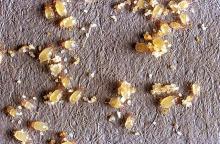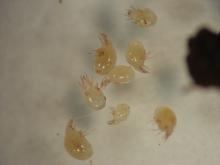Includes
Cheese mite (Tyrolichus casi)
Grain mite (Acarus siro)
Mold mite (Tyrophagus putrescentiae)
Pest description and damage Very small, light-colored mites often with very long body "hairs." They may infest stored foods and other organic material such as grain, flour, cereals, dried fruits and vegetables, mushrooms, meats, pet food, cheese, paper, tobacco, molds, bird and animal nests, etc. These mites are usually associated with moist or damp conditions. Piles of brownish "mite dust" may appear on open shelving, around the base of flour sacks, or on the surface of foods. These piles consist of dead and living mites, cast skins, and feces. Prolonged contact with mite infested foods may produce a mild dermatitis, and other contact may cause bronchial asthma and dust allergies. Also, if mites are taken internally with infested food, stomach disorders can result.
Management
Moisture control is critical: reduce moisture and promote air circulation in storage areas. Store foods only in clean, dry areas. If necessary, use a dehumidifier to reduce relative humidity and prevent mold and mildew. Rotate food materials to remove the older items first. Avoid prolonged storage and inspect bulk foods or feeds routinely. Place stored foods in containers with tight-fitting lids-ideally screw type. Periodically clean the storage areas, especially cracks, crevices, shelving, etc. When products become infested with mites, locate the source of infestation and eliminate it. Suspected mite infested foods can be supercooled (0°F for seven days in a deep freeze), superheated (140°F for 30 minutes in an oven using a shallow pan, or 5 minutes in a microwave), or securely wrapped and disposed of as garbage. If a pesticide is needed in the storage area, spot-treat cracks and crevices only to kill hidden mites.



